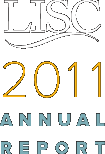Message From the Chair & President
It has been nearly impossible to talk about community development over the last few years without the economic downturn driving much of the conversation. It’s clear why, of course: foreclosures and unemployment have been devastating for the communities where we work. The losses are stark and durable. We know the impact all too well.

Robert Rubin,
Chair

Michael Rubinger,
President & CEO
But we also know this: the recession did not create the underlying challenges most impoverished places face. For communities shaped by decades of blight, the problems are deeper, more tangled, and more persistent than that. They need comprehensive investment strategies, committed private partners and responsive public policies if families are to live safer, healthier lives marked by opportunity, not poverty.
Our 2011 results certainly responded to all of that. LISC invested $1.1 billion in grants, loans and equity in disadvantaged neighborhoods last year and did so in ways designed to build lasting community assets and help families flourish. Our 2011 work brought LISC’s total investment activity to more than $12 billion over the last 31 years, with new jobs, homes, schools, grocery stores, parks, theaters, health centers, athletic fields, education programs, manufacturing facilities and office buildings where blighted, often toxic sites once stood.
And so, our work continues with our strategy of Building Sustainable Communities, an approach conceived and launched a number of years ago, before foreclosures took hold and job loss wearied so many families. It reflects our decades on the ground in troubled neighborhoods. And it incorporates our understanding of how various aspects of “community” connect to each other, together fueling a neighborhood’s growth.
Today, it almost seems obvious. Of course safe streets underpin stronger local businesses. And a stable residential base helps those businesses grow. Better housing connects to better health. Successful schools help attract and anchor families to a community, and local entrepreneurs create jobs and provide products and services that benefit those families. All of that bolsters the local tax base and contributes to stronger cities and towns.
The challenge—the difference in what LISC has been doing—is addressing all that at once in places where the dysfunction of one reinforces the deterioration of another. Building Sustainable Communities is the blueprint for building beyond that crippling spiral.
Our 2011 work illustrates how. LISC Financial Opportunity Centers, for example, continued to be a remarkable resource. Our growing network of Centers helped low-income families with employment, asset-building, budgeting and public benefits access, among other things. We now have more than 60 Centers in 23 cities around the country. Through them, people improve their incomes. They restructure upside-down mortgages and rein in credit card debt. They get the counseling they need to save and build for the future. They stabilize their long-term financial outlook.
Our support for education also focuses on lasting gains. In 2011, we continued to invest in public charter schools, early childhood education, after-school programs and service learning so low-income kids could access some of the same educational opportunities as their more affluent peers. Schools are neighborhood institutions. When they are dangerous and deteriorating, they consign both the children within them and the neighbors around them to more of the same.
That includes the local business community. In 2011, we brought new capital to crumbling commercial corridors and creative approaches to helping local business owners. For example, we leveraged our New Markets Tax Credit allocation to launch a small business development fund that links capital from LISC and Morgan Stanley to Small Business Administration lending. The fund is helping entrepreneurs launch new ventures and expand promising businesses in communities where disinvestment has long been the norm.
We also supported housing stability throughout the year—indeed, housing is always a critical piece of the work we do. In 2011, we led local responses to the foreclosure crisis, promoted new opportunities around preservation, and made record-level Low Income Housing Tax Credit investments through our National Equity Fund affiliate. With all that we focused on the needs of some of our communities’ most distressed residents, supporting housing for homeless veterans, the frail elderly and the disabled, in addition to thousands of working class families who now have access to decent homes within their means.
All of that is part of Building Sustainable Communities. It’s a national approach, but one that looks different in different communities, as we build on local capacity and respond to local need.
Consider our work around healthy food. Our goal is to fuel local economic activity, while helping low-income families short-circuit obesity, diabetes and other illnesses. In Brooklyn last year, we did that by supporting an urban farm stand in Cypress Hills operated by youth and supplied by local farmers. In Pittsburgh it was a new Target, set on a former industrial brownfield, now cleaned up and offering groceries as well as other goods. And in Houston, it was two new community gardens in areas where we work, in addition to expanded facilities for the Houston Food Bank, all done with LISC support.
Our community safety work reflects the same local approach. In Indianapolis, LISC helped drive police and resident training in the Crime Prevention Through Environmental Design program, and then targeted implementation grants to put the training into action. In eastern North Philadelphia, we helped reclaim a neighborhood park that had deteriorated and become a haven for gangs and crime. And through our At-Home in Duluth effort, we coordinated with local law enforcement and two leading nonprofits to connect safety and economic development, including support for a “blight team” to improve citywide responses to vacant property.
Running through much of LISC’s work is a focus on green building and design—including a new partnership in 2011 between LISC’s Green Development Center and the Natural Resources Defense Council to show how existing, urban neighborhoods can be examples of the highest level of sustainability. Our green efforts last year ran the gamut from weatherization and retrofits to green jobs programs to cutting-edge design, construction and even deconstruction of vacant homes. Indeed, green is embedded in our Building Sustainable Communities work because it offers healthier, more affordable homes, schools and green space for low-income families.
We were also fortunate to have the energy of 479 LISC/AmeriCorps members during 2011. They focused on everything from affordable housing development and foreclosure prevention to youth mentoring and financial counseling. Our AmeriCorps program is unique in that we draw our members from the communities where we work. They play a critical role in crafting solutions that improve their own neighborhoods.
That’s what LISC does, collectively, all over the country. It’s impossible to capture the full range of all our local work in this one space. Indeed, Building Sustainable Communities ties together so many strands of growth and opportunity that it might be difficult to envision how it comes together… that is, unless you walk down the streets of one of the neighborhoods where we work.
We are grateful for the support of our funders and investors, the drive of our community partners and the willingness of many policymakers to find creative ways to support this important work. It’s what allows us to be so engaged with low-income families as they build better lives and stronger neighborhoods.

Robert Rubin, Chair

Michael Rubinger, President & CEO
